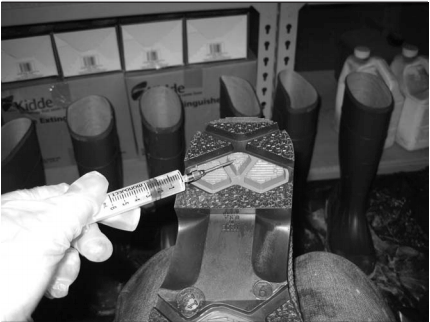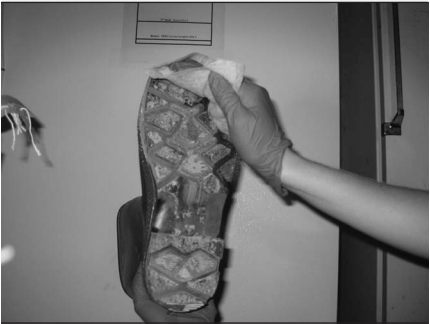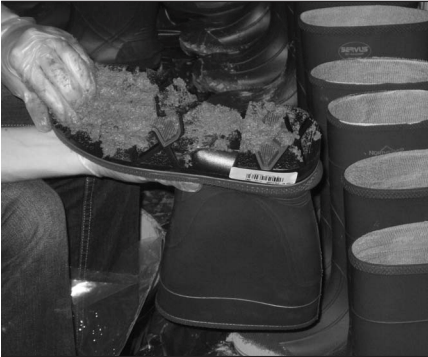An evaluation of Stalosan F powder for deactivation of PRRSv
Published: December 14, 2015
By: Casey Rabbe (University of Minnesota, St. Paul, Minnesota); Deb Murray (New Fashion Pork, Jackson, Minnesota); Amanda Sponheim (Boehringer Ingelheim Vetmedica Inc., St. Joseph, Missouri).
Introduction
Preventing the spread of PRRS virus (PRRSv) between groups of pigs is a major goal of pork producers. Many hog operations utilize liquid disinfectant boot baths as a part of biosecurity protocols aimed at minimizing the spread of PRRSv. Several problems arise from the current use of liquid disinfectant boot baths including their effectiveness following contamination with fecal matter and in freezing temperatures. The objective of this study was to test Stalosan® F, a powder disinfectant, as an alternative to a liquid disinfectant boot bath, for the deactivation of PRRSv under various temperatures and in the presence or absence of fecal matter.
Materials and methods
In Trial 1, clean, dry rubber boots (n = 24) were randomly assigned to one of two treatment groups (12/trt). Treatment groups consisted of boot baths containing either Stalosan F power (Vitfoss; Graasten, Denmark) or Synergize liquid disinfectant (ProAg; Winnipeg, Manitoba), following the manufacturers’ instructions at an environmental temperature of 85° F. The entire bottom of each boot was first wiped with a Swiffer® Sweeper pad soaked in 30 mL of a 2:3 dilution of deionized water to neutralizing broth. After sampling, each pad was squeezed into a plastic bag, and 10 mL were withdrawn using a pipette. The fluid was then placed in a collection tube and analyzed by PCR to verify absence of the virus. This technique was used for all testing performed during this trial. Additionally, each boot was placed in the respective treatment boot bath and again Swiffer sampled and tested by PCR to verify the absence of PRRSv in each bath prior to the start of the trial.
1 mL Ingelvac PRRS MLV was added to 99 mL of sterile water and inverted and reverted for 5 minutes to mix completely. 2 mL of the 1:100 dilution of re-constituted Ingelvac PRRS MLV vaccine was applied with a syringe to the bottom of each boot (Figure 1). The inoculated boot was then Swiffer sampled and tested by PCR to confirm presence of the virus. Inoculated boots were consecutively placed in each boot bath per treatment group, to simulate on farm conditions. The boots were Swiffer sampled and tested by PCR 1 min. post-disinfection (Figure 2). This dilution for inoculation was chosen approximating a typical infectious dose of PRRSv via oral and intranasal routes. The sensitivity of PRRSv PCR testing at this dilution of vaccine plus neutralizing broth and method of collection were validated by submission of 5 positive inoculated samples to two independent diagnostic laboratories.
2 mL of Ingelvac PRRS MLV vaccine of the same dilution was applied to a quarter cup of confirmed PCR negative fecal matter and mixed (Figure 3). Fecal matter was then applied to the bottom of each boot (Figure 4), Swiffer sampled, and tested by PCR to confirm the presence of the virus (12/trt). Inoculated boots were consecutively placed in each boot bath per treatment group, and the bottoms of the boots were Swiffer sampled and tested by PCR 1 min post-disinfection. This trial (with and without fecal matter) was then repeated with sampling after 3 min. and 5 min post-disinfection. A sample of each boot bath was taken at the completion of each treatment group (12/ trt) and tested by PCR.




In Trial 2, the environmental temperature was 8°F (a temperature below the freezing point of Synergize). The same method used in Trial 1 was repeated at this temperature; 1, 3 and 5 minutes post-disinfection; and with and without the presence of fecal matter on the bottom of the boot. Synergize was frozen at this temperature and unable to be tested.
Trial 3 was conducted in field conditions to demonstrate the use of Stalosan F powder baths in summer conditions and in the presence of fecal matter. A single flow weaning PRRSv negative piglets was used. Three nursery sites receiving piglets daily from this flow were sampled 5 days per week over an 8 week period of time as they received piglets. Piglets were vaccinated with Ingelvac PRRS MLV vaccine upon arrival to the nursery sites. Stalosan F powder boot baths were placed at the entry to the site and at the entries to each barn. Site protocol required the workers to step into the boot baths upon entry and exit to each barn. Thirty of the first piglets to arrive at the nursery site were bled weekly beginning one week post placement to confirm vaccine virus infection and shedding. The bottoms of a worker’s boots were Swiffer sampled daily, and tested by PCR.
Results and discussion
In trials 1 and 2, 260 Swiffer samples were collected and tested by PCR for the presence of PRRSv. Neither of the products tested resulted in 100% PRRSv PCR negative results under all conditions (Tables 1 and 2). Increasing exposure time did not improve (P > 0.10) the effectiveness of either disinfectant. The presence of fecal matter significantly reduced the effectiveness of Synergize but had no significant effect on Stalosan F. In the absence of fecal matter, Synergize appeared to be more effective compared to Stalosan F (Trt × Fecal matter; P < 0.0001). At 8°F and 85°F Stalosan F showed no significant difference (P > 0.10) in effectiveness with or without fecal matter with an average of 95.8% and 86.2% PCR negative samples respectively, under the conditions tested at both temperatures. Synergize was frozen at 8°F making it ineffective at deactivating PRRSv under the conditions tested at that temperature. At 85°F Synergize generated an average of 28% and 97.3% PCR negative samples with and without fecal matter present respectively, under the conditions tested at that temperature. There was no correlation between order of placement into each boot bath and PRRSv PCR results.
In trial 3, 210 serum samples and 40 boot Swiffer samples were collected and tested by PRRSv PCR. 100% of serum samples tested positive for PRRSv, confirming infection and shedding of vaccine virus at the sites being tested. 100% of the boots Swiffer sampled tested PCR negative for PRRSv, indicating that Stalosan F showed effectiveness in real nursery conditions in the presence of vaccine virus infection and shedding.
Stalosan F appears to be a viable alternative to Synergize as a disinfectant boot bath and offers advantages in the presence of fecal matter and freezing temperatures. Conclusions concerning virus deactivation warrant further investigation using virus isolation techniques and bioassay to determine virus viability.
Table 1: The effect of disinfectant over time in the presence or absence of fecal matter at 85ºF

Table 2: The effect of disinfectant over time in the presence or absence of fecal matter at 8ºF

References
Hermann, J.R. et al. Probability of porcine reproductive and respiratory syndrome (PRRS) virus infection as a function of exposure route and dose. Veterinary Microbiology. 2005: 7–16.
Kenney, K and D. Polson. Validation of Swiffer cloth-origin neutralizing broth samples for detection of PRRS virus in the environment. Proc. AASV. 2011: 95–107.
Related topics
Recommend
Comment
Share

Would you like to discuss another topic? Create a new post to engage with experts in the community.




.jpg&w=3840&q=75)